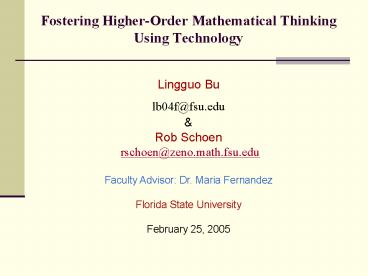Fostering HigherOrder Mathematical Thinking Using Technology - PowerPoint PPT Presentation
1 / 15
Title:
Fostering HigherOrder Mathematical Thinking Using Technology
Description:
'Eighth graders whose teachers used computers mostly for simulations and ... (Education Week on the Web, retrieved January 7, 2005) ... Albany, NY: SUNY Press. ... – PowerPoint PPT presentation
Number of Views:77
Avg rating:3.0/5.0
Title: Fostering HigherOrder Mathematical Thinking Using Technology
1
Fostering Higher-Order Mathematical Thinking
Using Technology
Lingguo Bu lb04f_at_fsu.edu Rob Schoen
rschoen_at_zeno.math.fsu.edu Faculty Advisor Dr.
Maria Fernandez Florida State University Februar
y 25, 2005
2
What does research say?
- Harold Wenglinskys findings
- Eighth graders whose teachers used computers
mostly for simulations and applications--general
ly associated with higher-order
thinking--performed better on NAEP than students
whose teachers did not. Meanwhile, 8th graders
whose teachers used computers primarily for
drill and practice--generally associated with
lower-order thinking--performed worse. - (Education Week on the Web, retrieved January
7, 2005). - Refer also to the National Educational Technology
Plan.
3
Learning Theory Bruners Three Modes of
Cognitive Representation
- Enactive (motor responses)
- Iconic (images)
- Symbolic (language, mathematical notations,
computational models)
Adults and kids alike learn best using
representations appropriate for their age and,
most importantly, their level of cognitive
development.
4
Mathematical Values of Sierpinskis Triangle
- Geometrically, it provides opportunity for
learners to explore symmetry, similarity,
transformation, etc. - Algebraically, it is rich in patterns, relations,
and measurement. - Cognitively, it affords a connection between
geometry and algebra, generating
thought-provoking discourse in the classroom. - Computationally, it invites reflections and
fosters learner ownership.
5
Multiple Approaches
- Lecture Lets talk about it.
- Hand-on Project Lets Cut.
- Paintbrush Lets draw on the computer.
- Computation Lets try programming.
6
The Lecture Approach
- Instructor-centered presentation
- Little or no learner participation
- Little interaction between learners and the
instructor. - Result knowledge with little understanding or
chance for knowledge transfer. - Benefit time management and faster coverage of
the lesson text.
7
Paper and Scissors
- We observed two types of construction building
and removing. - Benefits engages learners, provides hand-on
reference, generates discourse - Drawback instruction time and lower-order
understanding.
8
The Paintbrush Approach
- Using the painting tool, we observed two types of
behavior representing two types of understanding. - Replication (Copy Paste)
- representing a partial view of the fractal as an
outgrowing self-similar figure. - Recursive Division
- representing a partial view of the fractal as an
evolving structure on a microscopic scale.
9
Paintbrush Replication(copypaste)
10
Paintbrush Recursive Division
11
A Computational Approach
- To Draw a Sierpinski Triangle
- if it is the deepest level, draw a filled
triangle - otherwise
- Draw a sierpinski triangle in the lower-left.
- Draw a sierpinski triangle at the top
- Draw a sierpinski triangle in the lower-right.
12
A Mathematica Implementation
13
A Computational Approach
- Benefits
- Provides a scaffold for learners to explore the
various properties of the fractal toward an
in-depth understanding of the mathematics behind. - Helps develop an appreciation of mathematical
rules. - Generates a more detailed visualization of the
structure. - Enhance motivation for learners to take
initiative in their mathematical experience. - Drawbacks
- Software and hardware support.
- Experience in coding.
- Teachers knowledge of the integration of
mathematics and computing and related pedagogical
issues.
14
Recommendations for Instruction
- Hands-on projects and computer-assisted
exploration provide the foundation for learning
cognitive development their roles in the
classroom are not to be overlooked as learning
aids. - Instruction might follow the sequence of
ethnomathematical knowledge, to intuitive, to
technical symbolic, and axiomatic deductive
knowledge (Kieren, T. E. 1993). - Technology, especially, the computer, could be
used at various levels of the instruction to
facilitate learners visualization and
exploration. In particular, computer simulation
and learner-initiated programming contributes to
higher-order mathematical thinking.
15
Acknowledgement
- Work funded in part by Florida Department of
Education in its STTA Grant (Students
Transitioning Toward Algebra), directed Dr Maria
Fernandez and Dr. Monica Hurdal. - References
- Archer, J. (2005). The link to higher scores.
Education Week on the Web. - Bransford, John D., Ann L. Brown and Rodney
R. Cocking (ed). (1999). How People Learn
Brain, Mind, Experience, and School. Washington,
D.C. National Academy Press. - Driscoll, M. P. (2000) . Psychology of learning
for instruction. (2nd ed.). Boston, MA Allyn
and Bacon. - Sowder, J. T. et al. (1998). Middle-grade
teachers mathematical knowledge and its
relationship to instruction. Albany, NY SUNY
Press.































